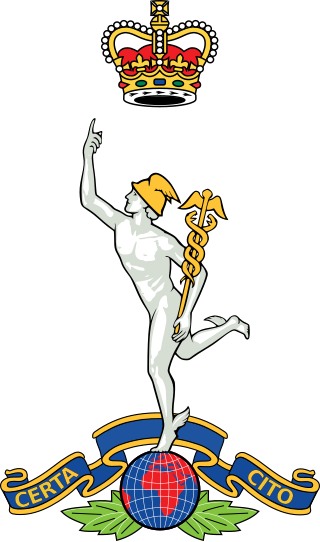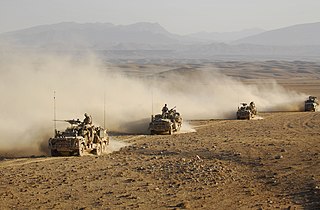
The British Army is the principal land warfare force of the United Kingdom, British Overseas Territories and Crown Dependencies, a part of the British Armed Forces along with the Naval Service and the Royal Air Force. As of 1 July 2024, the British Army comprises 74,296 regular full-time personnel, 4,244 Gurkhas, 25,934 volunteer reserve personnel and 4,612 "other personnel", for a total of 109,086.

The Special Air Service (SAS) is a special forces unit of the British Army. It was founded as a regiment in 1941 by David Stirling, and in 1950 it was reconstituted as a corps. The unit specialises in a number of roles including counter-terrorism, hostage rescue, direct action and special reconnaissance. Much of the information about the SAS is highly classified, and the unit is not commented on by either the British government or the Ministry of Defence due to the secrecy and sensitivity of its operations.

The Special Boat Service (SBS) is the special forces unit of the United Kingdom's Royal Navy. The SBS can trace its origins back to the Second World War when the Army Special Boat Section was formed in 1940. After the Second World War, the Royal Navy formed special forces with several name changes—Special Boat Company was adopted in 1951 and re-designated as the Special Boat Squadron in 1974—until on 28 July 1987 when the unit was renamed as the Special Boat Service after assuming responsibility for maritime counter-terrorism. Most of the operations conducted by the SBS are highly classified, and are rarely commented on by the British government or the Ministry of Defence, owing to their sensitive nature.

The Special Air Service Regiment, officially abbreviated SASR though commonly known as the SAS, is a special forces unit of the Australian Army. Formed in 1957 as a company, it was modelled on the British SAS with which it shares the motto, "Who Dares Wins". Expanded to a regiment in August 1964, it is based at Campbell Barracks, in Swanbourne, a suburb of Perth, Western Australia, and is a direct command unit of the Special Operations Command.

The 1st Commando Regiment is an Australian Army Reserve special forces unit, part of Special Operations Command with an integrated structure of regular (full-time) soldiers and reserve (part-time) soldiers, which together with the full-time Australian Army 2nd Commando Regiment, provides the commando capability to Special Operations Command. 1st and 2nd Commando companies were raised in 1955 and were combined with 126 Signal Squadron (SF) in 1981 to form the 1st Cdo Regt. The regiment's two commando companies are the oldest sub-units within Special Operations Command. In 2008, the regiment deployed to Afghanistan to become the first Australian Army Reserve force element on combat operations since World War II. The regiment is the Command's capability lead for special warfare.

The Royal Corps of Signals is one of the combat support arms of the British Army. Signals units are among the first into action, providing the battlefield communications and information systems essential to all operations. Royal Signals units provide the full telecommunications infrastructure for the Army wherever they operate in the world. The Corps has its own engineers, logistics experts and systems operators to run radio and area networks in the field. It is responsible for installing, maintaining and operating all types of telecommunications equipment and information systems, providing command support to commanders and their headquarters, and conducting electronic warfare against enemy communications.

The 21 Special Air Service Regiment (Artists) (Reserve), historically known as The Artists Rifles is a regiment of the Army Reserve. Its name is abbreviated to 21 SAS(R).

The Special Reconnaissance Regiment (SRR) is a special reconnaissance unit of the British Army. It was established on 6 April 2005 and is part of the United Kingdom Special Forces (UKSF).

16 Air Assault Brigade Combat Team, known simply as 16 Air Assault Brigade from 1999 – 2021, is a formation of the British Army predominantly based in Colchester, Essex. It makes up the Air Assault Task Force, a battlegroup held at high readiness, and is the only brigade in the British Army focused on operating via parachute, helicopter and air-landing.
General Sir Peter Edgar de la Cour de la Billière, is a former British Army officer who was Director SAS during the Iranian Embassy siege, and Commander-in-Chief of the British forces in Operation Granby.

The Special Forces Support Group (SFSG) is a special forces unit of the British Armed Forces. The SFSG was formed officially on 3 April 2006 to provide support to the Special Air Service, the Special Boat Service and the Special Reconnaissance Regiment on operations. It is a tri-service unit, composed of the 1st Battalion, Parachute Regiment,, a company of Royal Marine Commandos, and a flight (platoon) from the Royal Air Force Regiment.

The special forces of the Australian Defence Force are units of Special Operations Command and associated units of the Royal Australian Navy and the Royal Australian Air Force that conduct and or support special operations to advance and protect the national security of the Commonwealth of Australia. The special forces of Australia have a lineage to a variety of units raised in the Second World War such as the Independent and Commando Companies, Z Special Unit, Navy Beach Commandos, and the Coastwatchers. Australian special forces have most recently been deployed to Iraq in Operation Okra as the Special Operations Task Group, as the Special Operations Task Group in Afghanistan, in Afghanistan in support of the Australian Secret Intelligence Service and regularly for counter-terrorism pre-deploy to locations of major domestic events throughout Australia in readiness to support law enforcement such as the 2014 G20 Brisbane summit.
The history of the British Army's Special Air Service (SAS) regiment of the British Army begins with its formation during the Western Desert Campaign of the Second World War, and continues to the present day. It includes its early operations in North Africa, the Greek Islands, and the Invasion of Italy. The Special Air Service then returned to the United Kingdom and was formed into a brigade with two British, two French and one Belgian regiment, and went on to conduct operations in France, Italy again, the Low Countries and finally into Germany.
This is the Operation Herrick ground order of battle, which lists any British ground forces that have taken part in the duration of Operation Herrick between 2002 and 2014.
Director Special Forces (DSF) is the senior British Armed Forces officer responsible for the United Kingdom Special Forces. The post is a senior role within the Ministry of Defence (MoD). As director, the incumbent is responsible for the provision of special forces capability to MoD, and holds operational command for discrete special forces operations.
18 (UKSF) Signal Regiment is a regiment of the Royal Corps of Signals in the British Army that provides Communications and Information Systems (CIS) support to the United Kingdom Special Forces (UKSF). The regiment is under the operational command of the Director Special Forces and includes signal squadrons from both the Royal Corps of Signals and the Royal Navy.
United Kingdom Special Forces (UKSF) is a directorate comprising the Special Air Service, the Special Boat Service, the Special Reconnaissance Regiment, the Special Forces Support Group, 18 (UKSF) Signal Regiment and the Joint Special Forces Aviation Wing. In British freedom of information law, "special forces" has been defined as "those units of the armed forces of the Crown and the maintenance of whose capabilities is the responsibility of the Director of Special Forces or which are for the time being subject to the operational command of that Director". The Royal Marine Commandos and the Ranger Regiment are special operations–capable forces, but they do not form part of UKSF.
Army 2020 was the name given to the restructuring of the British Army in the early and mid-2010s, in light of the Strategic Defence and Security Review 2010. The plan, as its name suggested, was intended to be completed by 2020, though most of its reorganisations were completed by the middle of the decade. It was succeeded by Army 2020 Refine, a series of new changes and refinements of Army 2020's restructuring, conducted in light of the Strategic Defence and Security Review 2015.

The Intelligence, Surveillance and Reconnaissance Group is a formation of the British Army that commands the Army's miniature UAS, tactical UAS, counter-intelligence and reach back intelligence capabilities, the Specialist Group Military Intelligence and the Land Intelligence Fusion Centre.

The page contains the current structure of the British Army. The British Army is currently being reorganised to the Future Soldier structure.












